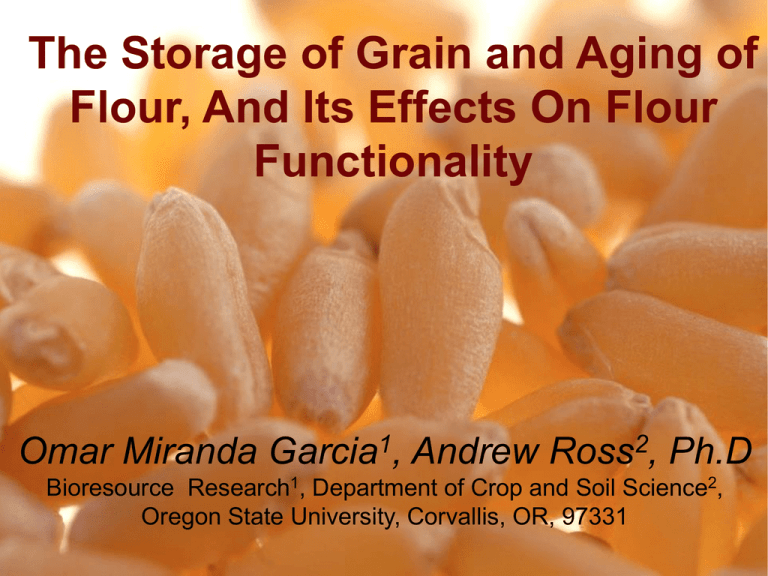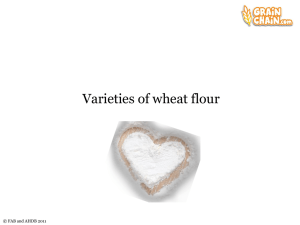View/Open - Oregon State University
advertisement

The Storage of Grain and Aging of Flour, And Its Effects On Flour Functionality Omar Miranda 1 Garcia , Andrew 2 Ross , Ph.D Bioresource Research1, Department of Crop and Soil Science2, Oregon State University, Corvallis, OR, 97331 Introduction: Wheat • Annual global production ~ 600 million metric tons • USA produces ~ 50 to 60 million metric tons • Oregon produces ~ 2 million metric tons valued at around $500 million 2 2 Wheat types • Wheat can be found in: 1. hard and soft 2. red and white 3. and in winter and spring growth habits 3 2 Project focus • The project focused on soft white (SW) winter wheat: the main wheat class produced in the Pacific Northwest. • Used for baked products such as: 4 http://www.squidoo.com/all-about-chocolate-cake 2 Grain anatomy and composition Grain anatomy Caryopsis 1. Outer Bran 2. Endosperm 3. Germ 6 http://articles.urbanhomemaker.com/index.php?article=846 2 Flour is primarily endosperm and has 3 main functional components 1. Starch 2. Gluten proteins 3. Arabinoxylans 7 3 Flour has 3 main functional components • All 3 contribute to overall water absorption of flour. • Absorption is highly relevant to preparation of doughs and batters for baked goods. 8 3 Relevance http://obozrevatel.com/politics/hleb-mozhet-podorozhat-na-15-20.htm 9 http://www.dreamstime.com/stock-photos-production-cookie-factory-image15173013 2 Starch • 70% of wheat flour weight: consists of two types of polymeric glucose: 1. Amylopectin (75%) 2. Amylose (25%) • Packaged in “granules” 10 2 Starch granules (Vandeputte & Delcour, 2004) 11 2 Damaged starch granules • Up to 10% of granules are damaged during milling • Damaged granules have higher absorption capacity Gluten • Found in the endosperm as gluten-forming proteins. • Two main components: 1. Polymeric glutenins 2. Monomeric gliadins 13 2 Gluten • Characteristics of gluten make it the main quality determinant in bread making. • Though its not a key determinant for cookie performance, it is a key determinant of flour functionality for crackers 14 2 Arabinoxylans • Arabinoxylans (AX) are located in the cell walls of the endosperm. • Contribute to the texture (softness or hardness) of the kernel. • Two categories: 1. Water un-extractable (WUAX) 2. Water extractable (WEAX) 2 15 Arabinoxylans • Negative impacts: Smaller cookie diameters • Positive impacts: in bread-making WEAX 16 2 Flour composition • Variation in flour composition is economically and functionally important for manufacturing processes and the resulting end-products. • Different types of wheat are differentially suitable for any particular end product. 17 2 Flour for bread Production • High Water absorption • High gluten strength • Moderately high damaged starch • High WEAX Flour for cookie Production • Low water absorption • Minimal gluten strength • Low damaged starch • Low AX Wheat Flour Aging • Naturally occurring maturation of flour when exposed to oxygen and light. • Modification of flour parameters. 19 3 Hypothesis • In SW wheat, aging may increase absorption properties of the flour. 20 3 Aims The aim of this study was to determine if absorption capacity of SW wheat flour changes as a response to grain storage and flour aging using Solvent Retention Capacity Test (SRC: a measure of flour absorption capacity and functionality). 21 4 Aims To determine if SRC testing can be done immediately after harvest and/or milling or whether a period of aging was necessary to obtain valid flour functionality measurements. 22 4 Materials and Methods Materials and testing schedule • Double aging study Grain and Flour • 4 Different varieties were chosen Based on preliminary data obtained from surveying grain from a prior harvest 10 24 Materials and testing schedule • Grain from 4 soft-wheat varieties 1. Tubbs 2. Goetze 3. Skiles 4. Bobtail 25 10 Materials and testing schedule Grain Aging Week 0 Week 3 Week 6 Week 12 Week 24 Milling 0 0 0 0 0 1 1 1 1 1 Flour Aging (days) 3 6 13 27 3 6 13 27 3 6 13 27 3 6 13 27 3 6 13 27 SRC Test 62 62 62 62 62 26 10 Milling Process • Milling aims to separate the anatomical parts of the kernel to produce flour with minimal inclusion of bran particles 27 10 Milling Process 28 10 SRC profile • Four tests, using 3 different aqueous solutions and water: • Water • 5% (w/w) Sodium Carbonate • 50% (w/w) Sucrose • 5% (w/w) Lactic Acid 5 29 SRC workflow 30 6 Principle of SRC Small molecules dissolve in excess amounts of solvent, but specific macro polymers can hydrate and easily entangle rather than dissolve. Different solvents exaggerate the swelling of specific polymeric networks. 31 8 Principle of SRC Water SRC Damaged starch Arabinoxylan 8 32 Sucrose SRC Arabinoxylan 33 9 Carbonate SRC Damaged starch 34 9 Lactic acid SRC 35 9 Results Water SRC Swelling of all Functional Components 37 11 Water SRC Swelling of all Functional Components 38 11 Sucrose SRC Arabinoxylans & Gliadins 39 11 Sucrose SRC Arabinoxylans & Gliadins 40 11 Carbonate SRC Damaged Starch 41 12 Carbonate SRC Damaged Starch 42 12 Carbonate SRC Damaged Starch Week 0: Days after milling 43 12 Lactic acid SRC Glutenin 44 12 Lactic acid SRC Glutenin 45 12 Conclusions • Systematic differences in SRC were observed between varieties at all grain storage and flour aging stages. 46 14 Conclusions • SRC values of SW wheat did change in response to grain storage and flour aging. 47 14 Conclusions • These results suggest that SRC testing could be done immediately after harvest and/or milling, if the primary aim was to determine differences between varieties. 48 14 Conclusions • Being able to test differences between varieties [genotypes] immediately after harvest is vital for wheat breeding programs due to the necessity for high throughput in short time frames. 49 14 Conclusions • If the primary aim was to predict flour functionality for commercial production then the small but significant changes in SRC across the grain storage and flour aging periods need to be accounted for. 50 14 Conclusions • Water and sucrose SRCs showed small but significant increases across the grain storage and flour aging periods. • Partially supports the original hypothesis. 51 14 Conclusions • Sodium carbonate SRC was significantly higher when tested on freshly milled flour from freshly harvested grain. 52 14 Conclusions • Lactic acid SRCs had significant decreases across the grain storage and flour aging periods. • Partially refutes the original hypothesis. 53 14 Further Research •In parallel the oxidative gelation test AX cross linking 54 14 Further Research AX cross linking Means and 95.0 Percent LSD Interv als 450 P e a k V i sc . 430 410 390 370 350 0 1 3 6 13 27 62 Flour Age - Days 55 14 Further Research AX cross linking Tubbs 900 800 700 Viscocity (cP) 600 Week 0 Week 3 500 Week 6 400 Week 13 Week 24 300 200 100 0 0 50 100 150 Total Days Spent14Aging 200 250 56 References Bettge, A. D., & Morris, C. F. (2007). Oxidative gelation measurement and influence on soft wheat batter viscosity and end-use quality. Cereal Chemistry, 84(3), 237–242. doi:10.1094/CCHEM-84-3-0237 Delcour, J. A., & Hoseney, R. C. (2010). Principles of Cereal Science and Technology (3, illustrated.). AACC International. Duyvejonck, A. E., Lagrain, B., Pareyt, B., Courtin, C. M., & Delcour, J. A. (2011). Relative contribution of wheat flour constituents to Solvent Retention Capacity profiles of European wheats. Journal of Cereal Science, 53(3), 312–318. doi:10.1016/j.jcs.2011.01.014 Hoseney, R. C. (1986). Principles of cereal science and technology (Vol. 327). St. Paul, Minnesota, USA; American Association of Cereal Chemists. Kweon, M., Slade, L., & Levine, H. (2011). Solvent Retention Capacity (SRC) Testing of Wheat Flour: Principles and Value in Predicting Flour Functionality in Different Wheat-Based Food Processes and in Wheat Breeding-A Review. Cereal Chemistry, 88(6), 537–552. doi:10.1094/CCHEM-07-11-0092 Oregon Agriculture & Fisheries Statistics. (2011, 2012). Retrieved May 23, 2013, from http://www.oregon.gov/ODA/docs/pdf/pubs/agripedia_stats.pdf Zeeman, S. C., Kossmann, J., & Smith, A. M. (2010). Starch: Its Metabolism, Evolution, and Biotechnological Modification in Plants. Annual Review of Plant Biology, 61(1), 209–234. 16 doi:10.1146/annurev-arplant-042809-112301 57 Acknowledgments • The Multicultural Scholars Program (MSP) • National Institute of Food and Agriculture (NIFA) • US Department of Agriculture (USDA); • College of Agricultural Sciences, ER Jackman Internship Support Program • College of Agriculture Sciences, Calvin & Merle Smith Wheat Research Endowment Fund 16 58 Acknowledgments • Wanda Crannell • Dr. Andrew Ross • Dr. Michael Penner • Dr. Katharine Field 59 16








